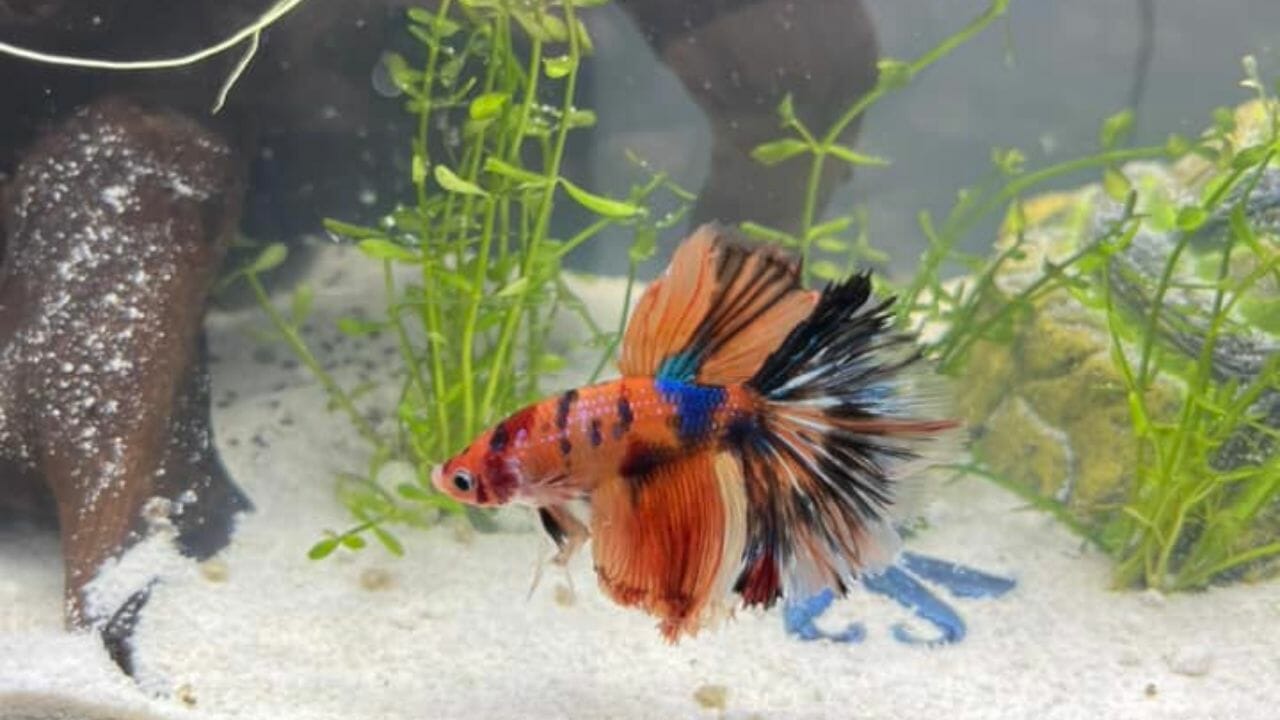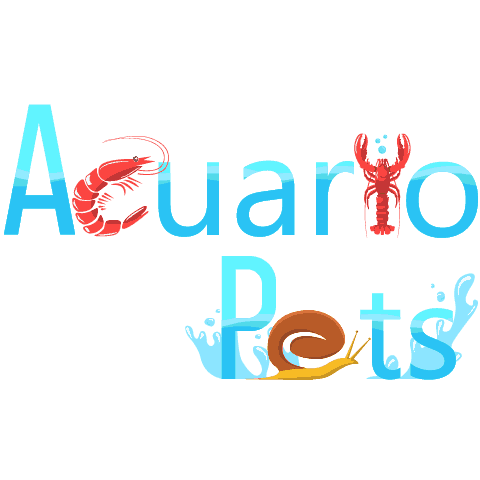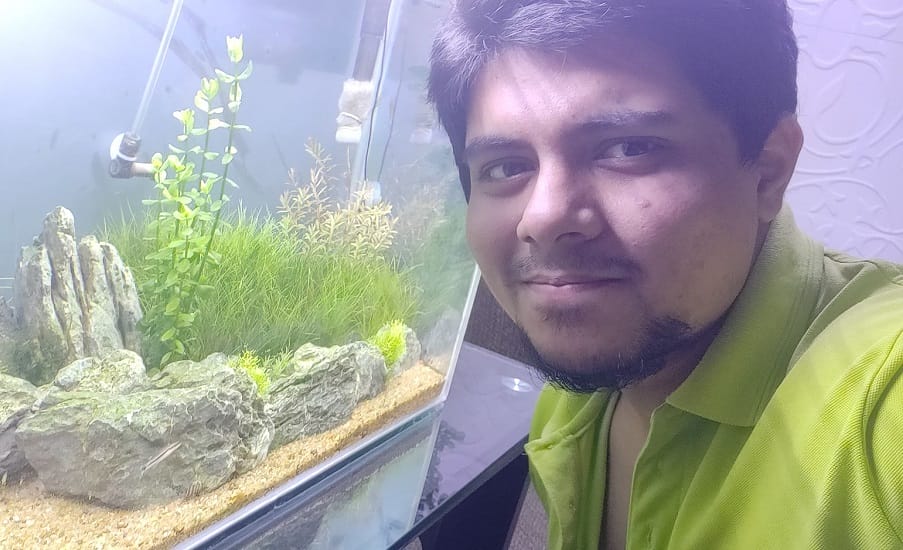This post was created with help from AI tools and carefully reviewed by a human (Muntaseer Rahman) . For more on how we use AI on this site, check out our Editorial Policy.
Check Out These FREE Tools We Made JUST For You!
Choosing the Right Substrate for Bettas (And Why Color Matters)

Look, I get it. You walk into the pet store and see that wall of colorful gravel, and suddenly you’re thinking your betta needs to live in a Lisa Frank fantasy world.
But hold up. That bright neon pink gravel might look cool to you, but to your betta? It could be seriously stressing them out.
Let’s talk about why the stuff at the bottom of your tank matters way more than you think.
The Shocking Truth About Substrate Color
Here’s something that’ll blow your mind: fish can’t squint.
Seriously. They don’t have eyelids like we do, and they definitely can’t throw on a pair of Ray-Bans when things get too bright.
So when you dump bright white or neon-colored sand in their tank, you’re basically forcing them to stare into a mirror that’s reflecting light right back into their eyeballs all day long. It’s like being stuck at the beach without sunscreen for your retinas.
Research from aquarium communities and fish keepers has shown that white sand can stress fish out by reflecting light back up at their eyes, similar to being in blazing sunlight without protection. Some keepers have even reported that bright white substrates caused color fading and increased stress in their fish.
Think about where bettas come from. They live in rice paddies, slow-moving streams, and shallow ponds in Southeast Asia. The bottoms of these places? Dark. Muddy. Definitely not hot pink.
Why Dark Substrates Are Your Betta’s Best Friend
Dark substrates, especially black, make fish colors pop visually and can reduce stress by mimicking their natural environments.
But here’s the catch. If you’ve got a black betta on black substrate, good luck finding him. You’ll be playing “Where’s Waldo” every feeding time.
The general rule? Match the substrate to your fish’s comfort, not just your viewing pleasure.
If your fish is dark, use a lighter substrate for visibility, and vice versa. But when in doubt, go darker. Your betta will thank you.
The Great Substrate Showdown: Sand vs. Gravel vs. Aquasoil
Alright, let’s break down your options.
Sand: The Soft Touch
Sand is a good substrate choice for bettas because it’s naturalistic, comfortable for their fins, and its tiny grains won’t damage delicate fins like gravel sometimes can.
The good stuff: Waste sits right on top, so it’s super easy to see and vacuum out. Your betta can actually lay on it without getting scratched, and they seem to love the feeling on their bellies.
The annoying stuff: You’ve got to stir it every couple weeks or you’ll get pockets of nasty hydrogen sulfide gas forming underneath. Also, if you’re not careful with your gravel vac, you’ll suck up half your substrate into your bucket.
Pro tip: Hover your vacuum about an inch above the sand instead of jamming it in there.
Popular choices: CaribSea Super Naturals comes in natural colors and won’t mess with your water chemistry. Or if you’re on a budget, Black Diamond blasting sand from Tractor Supply is aquarium-safe and costs about $8 for a 50-pound bag.
Gravel: The Classic Choice
Gravel is lightweight, not difficult to clean, and provides surface area for beneficial bacteria to thrive.
The good stuff: Easy to vacuum, allows water flow, and you can’t accidentally suck it all up during cleaning. It’s also too large for bettas to accidentally swallow.
The annoying stuff: Waste and uneaten food can fall between the gravel pieces, making it harder to clean thoroughly than sand. And if you pick gravel with sharp edges, you’re basically setting up a fin-shredding obstacle course.
Critical rule: Avoid any gravel with sharp edges that can catch and tear your betta’s delicate fins. Run your fingers through it first. If it feels scratchy, skip it.
Good options: Seachem Flourite Black Clay Gravel is smooth, benefits plants by absorbing nutrients from the water, and has that sleek dark look. AquaNatural Diamond Black is made from natural quartz and makes colors pop.
Aquasoil: The Plant Person’s Dream
This is basically dirt. Fancy aquarium dirt, but still dirt.
The good stuff: Aquasoil provides nutrients for plants and naturally lowers pH, making water more acidic like bettas prefer. If you want a jungle tank, this is your jam.
The annoying stuff: It releases ammonia when you first set it up, so you MUST cycle your tank completely before adding fish. No shortcuts here or you’ll poison your betta.
Best choice: ADA Amazonia produces the best results for heavily planted betta tanks with lots of color and fast growth. Carib Sea Eco-Complete is pre-cycled and packed with nutrients like iron, potassium, and magnesium.
The Science Behind Substrate Color
Let’s get nerdy for a second.
Studies on fish like Nile tilapia found that blue light reduced stress compared to white light, which increased ventilatory frequency after confinement stress. Research has linked tank color to changes in fish behavior, with lighter colors increasing aggression in some species.
The takeaway? Light environments can genuinely stress fish out. It’s not just about looks.
Dark substrates can reduce stress in some fish species by mimicking natural environments, while light substrates are preferred by species from naturally brighter, sandy environments.
Your betta’s ancestors? Not beach fish. They’re from dark water habitats with leaf litter and mud.
What You Should Actually Buy
Here’s my straight-up recommendation based on what actually works:
For beginners: CaribSea Super Naturals Aquarium Sand in a dark natural color – it’s inert, easy to maintain, looks great, and won’t change your water chemistry.
For plant lovers: Seachem Flourite Black – smooth enough for betta fins, dark enough to make colors pop, and plants will actually grow in it with some root tabs.
For the ambitious: ADA Amazonia if you want that Instagram-worthy planted tank, but only if you’re willing to cycle properly and maintain it.
For the broke college student: Black Diamond blasting sand (20/40 grit) – looks professional, costs nothing, safe for years of use.
The Color Matching Game
Your betta’s color matters for substrate choice, but maybe not how you think.
Red, blue, or multi-colored bettas: Go dark. Black or dark brown substrate will make them look absolutely stunning.
White, platinum, or very pale bettas: You can get away with medium-toned substrates. Still avoid bright white though.
Black or very dark bettas: This is the only time light-to-medium substrate makes practical sense. Otherwise you’ll never find your fish. But if you want your betta’s comfort over your convenience, still go dark and just look harder.
Common Mistakes People Make
Don’t be that person who uses glass marbles. Seriously. Marbles trap waste in the gaps, don’t look natural, and are often chosen for aesthetics over the betta’s actual needs.
Don’t pick colored gravel from the craft store. Always ensure substrate is specifically designed for aquariums and certified as fish-safe. That dollar store stuff can leach toxins.
Don’t skip substrate entirely – while bare-bottom tanks are easier to clean, they can stress bettas because they’ll see their own reflection and think there’s another fish in their territory.
Don’t forget to rinse. Whatever you buy, rinse it thoroughly with clean running water before adding it to your tank. Otherwise you’ll have cloudy water for days.
How Much Do You Actually Need?
Use 1-2 inches of substrate depth, which works out to about 1.5 pounds of substrate per gallon of water.
For a 5-gallon tank, that’s 7-8 pounds of substrate. For a 10-gallon, you’re looking at 15 pounds.
Don’t go thicker unless you’re doing serious planted tank stuff. More depth = more maintenance and more chances for anaerobic pockets in sand.
Maintenance: Keep It Clean Without Losing Your Mind
For sand: Hover your gravel vac about an inch above the surface and let the flow pull up waste without sucking up sand. Stir the sand gently with your finger every water change to prevent gas pockets.
For gravel: Push that vacuum right down into it. You want to get all the gunk that falls between the pieces.
For aquasoil: Be gentle. Soil can get messy and cloudy if disturbed too much, and you can’t move plants around easily once they’re rooted.
The Bottom Line (Pun Intended)
Your substrate choice matters. It affects your betta’s stress levels, the brightness of their colors, how easy your tank is to maintain, and whether your plants will actually survive.
The short version: Go with a dark, natural-colored sand or smooth gravel. Your betta will be more comfortable, their colors will pop, and you won’t be fighting algae visibility or stress-related health issues.
Skip the bright colors. Skip the craft store finds. Skip anything that feels sharp.
And remember: your betta is living in this tank 24/7. What looks cool to you for five minutes when you walk by doesn’t matter nearly as much as what keeps them healthy and happy for years.
Now get out there and pick some substrate that won’t make your fish need therapy.
About Author
Hello, I’m Muntaseer Rahman, the owner of AcuarioPets.com. I’m passionate about aquarium pets like shrimps, snails, crabs, and crayfish. I’ve created this website to share my expertise and help you provide better care for these amazing pets.
Disclaimer
This site is owned and operated by Muntaseer Rahman. AcuarioPets.com is a participant in the Amazon Services LLC Associates Program, an affiliate advertising program designed to provide a means for sites to earn advertising fees by advertising and linking to Amazon.com. This site also participates in other affiliate programs and is compensated for referring traffic and business to these companies.

